- Bernard Preston homepage
- Beekeeping
- Old Hives for Traps
Old hives for traps
Old hives for traps are the simplest way to increase an apiary. But I would far rather have five strong colonies than twenty weak ones.
Honeybees by their very instinct have a powerful swarming drive. It is nature's way of reproduction and simultaneously strengthens the old colony with a young virgin queen; one that is able to lay more eggs.
Strong hives will send off multiple small colonies to start anew in someone's roof; or your trap.
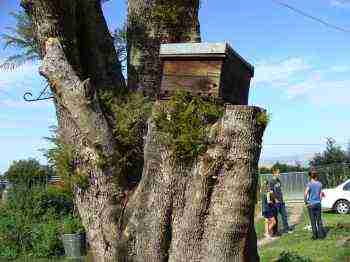
In many ways this is not helpful. Neither for the homeowner who has to deal with a pest in his roof, nor the beekeeper who loses much of his workforce.
The only place to get an old hive is a local 'keeper. Join the association before making a start; one of those you meet will surely sell you a box that reeks of bees. It does not really matter if it has got holes and looks a bit decrepit; in fact that may be a plus.
It must just have the smell of bees. A week or two after a feral swarm moves in, you can transfer them into a new hive. Then use full foundation; it speeds up the growth of the colony and reduces the tendency to build drone cells.
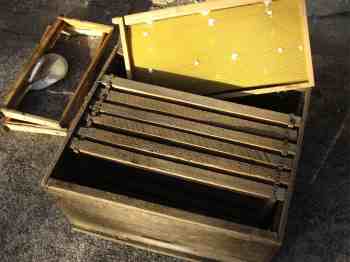 A full sheet of foundation wax
A full sheet of foundation waxSmall trap hives
The trap shown above is in fact the normal Langstroth box; but beekeepers often use small hives for catching feral colonies. Usually they would have five frames instead of ten; they are easier to move.
Place two frames with old combs at the edges; with three in the centre that have only strips of wax a few centimetres wide. The new swarm needs an area in which they can clump.
Many novices get caught out. They see bees buzzing around the trap
hive and think a swarm has moved in; but it's only the initial scouts
inspecting the box to check if it is suitable.
How soon can the trap hive be moved to a permanent location?
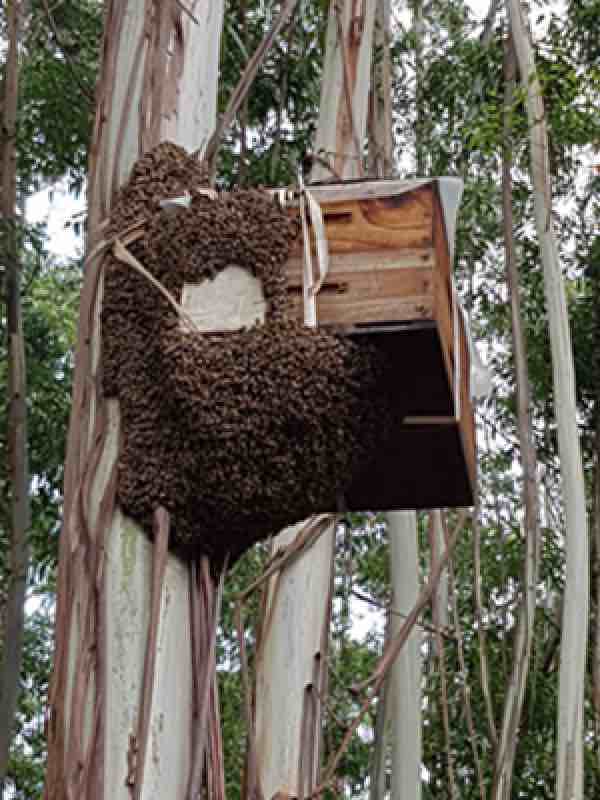
This old hive trap has been sorely neglected. It was hung up in a tree to entice a feral swarm and then forgotten. It is now so heavy and cumbersome that moving it to a permanent location has become hugely problematic. There are combs filled with brood in that clump below the box; it could have a second queen.
The rule of thumb is that the trap hive should be moved to its permanent location within three weeks; before new brood begins to hatch. Thereafter the bees start to become aggressive
During a honey-flow the box may become very heavy in a short period of time making it difficult to move.
You could shift the trap hive the very same
evening that they moved in; in fact if you want to shift them a short
distance, that is the best practice. After three weeks the new bees will be hatching
and it will become increasingly difficult; and heavier as they collect
nectar.
A week would be a good average time to move the trap hive to its permanent site; let them settle in a bit.
Different sizes of trap hives
Feral swarms come in varying sizes; they may be little bigger than a fist or as large as a football. Tiny colonies will not be interested in a trap hive consisting of a brood-chamber as in the photo above.
A huge feral swarm would pass a five-frame hive right by; a massive opportunity lost to the beekeeper. It's best to have a few trap boxes out, some large and others small.
Old hives for traps
Old hives for traps may be easy but requeening and splitting colonies would achieve other important goals.
For the more experienced "Beek" requeening is a better way to increase the size of the apiary. Every second hive then will have a new young virgin that can lay far more eggs; an increased workforce will deliver more bottles of honey.
Using queen cells from the best colony would be invoking Darwin's theory of natural selection.
In addition the swarming instinct is greatly reduced; it is unlikely a hive with a young virgin queen will send off small feral colonies taking away a large part of the workforce.
During the growth of new queen cells it has been noted that hives forage much less; for a three week period little nectar is brought into the hive. That is another significant loss for the beekeeper that would be averted by splitting colonies.
Swarming bees
In short swarming bees are a mixed blessing. They are one way to increase the size of the apiary but there are many good reasons to discourage hives from sending off feral colonies that can be a menace to society.
Before starting an apiary in the garden just make sure no one in the family is very allergic to beestings; or immediate neighbours. Local pain and swelling at the site is normal but any reaction at a distant part, especially the face and throat must be taken seriously.
Raw honey
Starches in general and especially simple carbs have come under the hammer in an increasingly obese society; and rightly so. But natural honey from a local "Beek" has a low GI; it's not fattening[1].
In fact natural honey astonishingly is being used for diabetic patients to lower their fasting blood glucose[2]; and together with freshly-grated turmeric in a salve for treating bedsores at home.
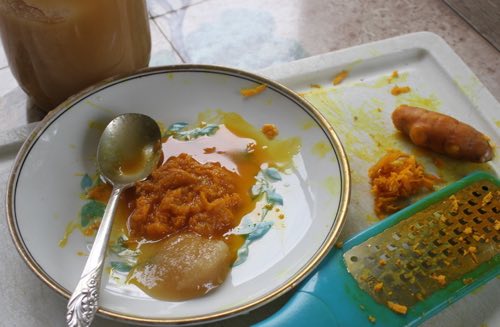 Turmeric and raw honey for bedsores.
Turmeric and raw honey for bedsores.Honey mead
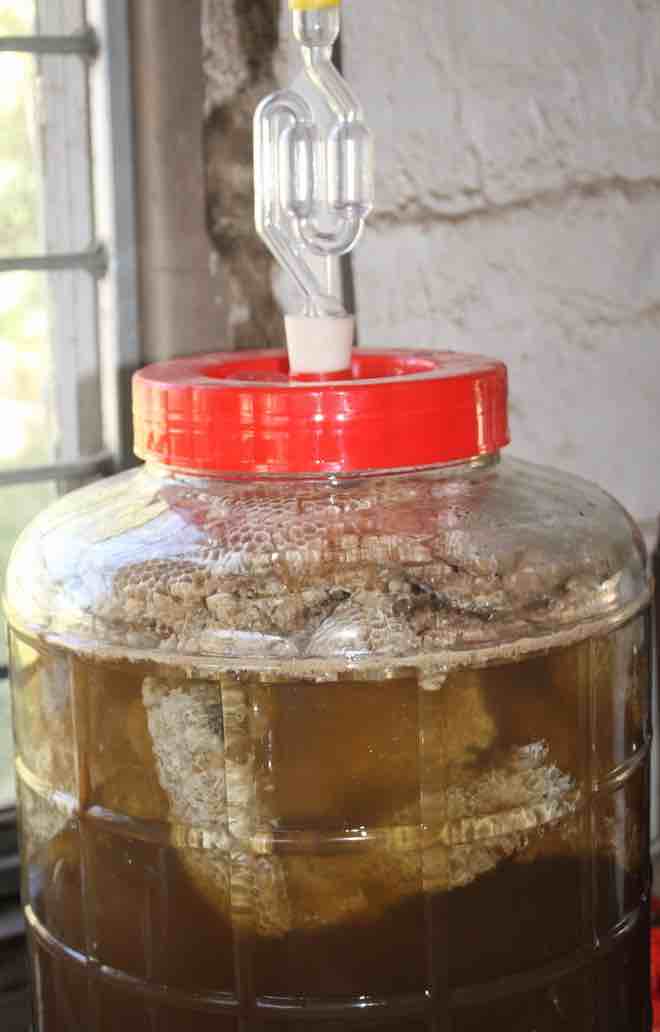 Brewing honey mead
Brewing honey meadUnusual hobbies often lead to other stimulating diversions. There is renewed interest worldwide in brewing honey mead as a natural form of alcohol that is thought not to increase the likelihood of cancer; as is alas the proven case for all commercial booze.
When browsing use right click and "Open Link in New Tab" or you may get a bad gateway signal.
Newsletter
Our newsletter is entitled "create a cyan zone" at your home, preserving both yourself and Mother Earth for future generations; and the family too, of course. We promise not to spam you with daily emails promoting various products. You may get an occasional nudge to buy one of my books.
Here are the back issues.
- Lifestyle and ideal body weight
- What are ultra-processed foods?
- Investing in long-term health
- Diseases from plastic exposure
- Intensive lifestyle management for obesity has limited value
- A world largely devoid of Parkinson's Disease
- The impact of friendly bacteria in the tum on the prevention of cancer
- There's a hole in the bucket
- Everyone is talking about weight loss drugs
- Pull the sweet tooth
- If you suffer from heartburn plant a susu
- Refined maize meal and stunting
- Should agriculture and industry get priority for water and electricity?
- Nature is calling
- Mill your own flour
- Bake your own sourdough bread
- Microplastics from our water
- Alternative types of water storage
- Wear your clothes out
- Comfort foods
- Create a bee-friendly environment
- Go to bed slightly hungry
- Keep bees
- Blue zone folk are religious
- Reduce plastic waste
- Family is important
- What can go in compost?
- Grow broad beans for longevity
- Harvest and store sunshine
- Blue zone exercise
- Harvest and store your rainwater
- Create a cyan zone at your home
Did you find this page interesting? How about forwarding it to a friendly book or food junkie? Better still, a social media tick would help.
- Bernard Preston homepage
- Beekeeping
- Old Hives for Traps
Address:
56 Groenekloof Rd,
Hilton, KZN
South Africa
Website:
https://www.bernard-preston.com